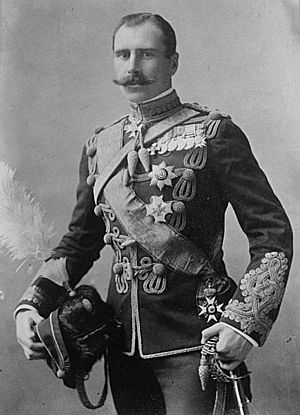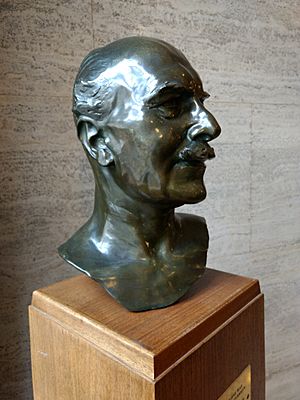Alexander Cambridge, 1st Earl of Athlone facts for kids
Quick facts for kids
The Earl of Athlone
|
|
|---|---|
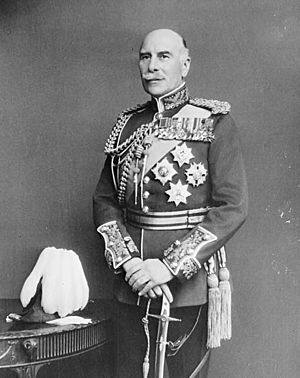
Portrait, c. 1940
|
|
| 16th Governor General of Canada | |
| In office 21 June 1940 – 12 April 1946 |
|
| Monarch | George VI |
| Prime Minister | William Lyon Mackenzie King |
| Preceded by | The Lord Tweedsmuir |
| Succeeded by | The Viscount Alexander of Tunis |
| 4th Governor-General of South Africa | |
| In office 21 January 1924 – 21 December 1930 |
|
| Monarch | George V |
| Prime Minister | Jan Smuts J. B. M. Hertzog |
| Preceded by | Prince Arthur of Connaught |
| Succeeded by | The Earl of Clarendon |
| Personal details | |
| Born |
Prince Alexander of Teck
14 April 1874 Kensington Palace, London, England |
| Died | 16 January 1957 (aged 82) Kensington Palace, London, England |
| Resting place | Royal Vault, St George's Chapel, Windsor Castle; later Royal Burial Ground, Frogmore |
| Spouse | |
| Children | Lady May Abel Smith Rupert Cambridge, Viscount Trematon Prince Maurice of Teck |
| Parents | Francis, Duke of Teck Princess Mary Adelaide of Cambridge |
| Education | Eton College; Royal Military Academy Sandhurst |
| Profession | Army officer |
| Awards | See below... |
| Military service | |
| Allegiance | United Kingdom |
| Branch/service | British Army |
| Years of service | 1894–1931 |
| Rank | Major-General |
| Battles/wars | |
Alexander Cambridge, 1st Earl of Athlone (born Prince Alexander of Teck; 14 April 1874 – 16 January 1957) was a member of the British royal family. He was also a British Army commander. He served as Governor-General of the Union of South Africa and Governor General of Canada.
Prince Alexander was born in London. His parents were the Duke and Duchess of Teck. He went to Eton College and the Royal Military College, Sandhurst. In 1904, he married Princess Alice of Albany. He became a higher-ranking officer during his service in the First World War. He received many awards for his bravery.
Alexander was a cousin and brother-in-law of King George V. In 1917, he gave up his German titles. These included his title as Prince of Teck. He was then given the title of Earl of Athlone in the peerage. In 1923, King George V chose Lord Athlone to be South Africa's governor-general. He held this important role until 1930. Athlone then became the Chancellor of the University of London. In 1940, his nephew George VI appointed him as Canada's governor general. He served in Canada until 1946. Athlone helped strengthen Canada's efforts during the Second World War. He also hosted important British and American leaders.
After returning to the United Kingdom, Athlone helped plan the coronation of Queen Elizabeth II. She was his great-niece. He passed away at Kensington Palace in 1957. He was buried at the Royal Burial Ground, Frogmore.
Contents
Early Life and Military Service
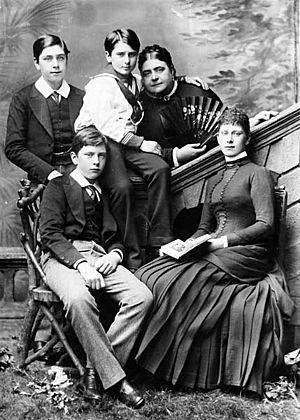
Prince Alexander of Teck was born at Kensington Palace on 14 April 1874. He was the fourth child of Prince Francis, Duke of Teck, and Princess Mary Adelaide, Duchess of Teck. Even though his mother was King George III's granddaughter, Alexander was known as His Serene Highness Prince Alexander of Teck. This was because his father was a prince from Württemberg. His family and friends called him Alge. He was known as a careful person who could be quick-tempered but also tactful.
When Prince Alexander was nine, his parents left the United Kingdom. They had many debts and stayed in Europe for two years. Prince Alexander stayed at Eton College. Later, he went to the Royal Military College, Sandhurst. In October 1894, he became a second lieutenant in the 7th Queen's Own Hussars. Soon after, he served in the Second Matabele War. He was mentioned for his brave actions during this conflict. In December 1898, Queen Victoria made him a Knight Commander of the Royal Victorian Order. He was promoted to lieutenant in June 1899 and captain in April 1900. For his actions in the Second Boer War, King Edward VII made him a Companion of the Distinguished Service Order in April 1901.
On 16 November 1903, it was announced that Prince Alexander was engaged. He was to marry his second cousin once removed, Princess Alice of Albany. She was Queen Victoria's granddaughter. They married at St. George's Chapel, in Windsor Castle, on 10 February 1904. Six days later, he was promoted to a Knight Grand Cross of the Royal Victorian Order. They had three children: Princess May of Teck (born 1906), Prince Rupert of Teck (born 1907), and Prince Maurice Francis George of Teck. Sadly, Maurice lived for less than six months.
First World War and Name Change
Before the Great War started in 1914, Prince Alexander was a major. He was also a temporary lieutenant-colonel leading the 2nd Life Guards. The British Prime Minister, H. H. Asquith, suggested him to be Governor General of Canada. However, the Prince was called to fight with his regiment. He served in France and Flanders. In December 1915, he was promoted to lieutenant colonel and temporary brigadier-general. For his service in the war, King George V made him a Companion of the Order of St. Michael and St. George in June 1917.
During the war, many people in the British Empire felt strongly against Germany. This led the King to change the royal family's name. It changed from the German House of Saxe-Coburg and Gotha to the English House of Windsor. The King also gave up all his German titles. On 14 July 1917, Alexander and his brother, Prince Adolphus, Duke of Teck, also gave up their German titles. They chose the name Cambridge, after their grandfather. Alexander was then known as Sir Alexander Cambridge. On 7 November 1917, the King made him Earl of Athlone and Viscount Trematon. Athlone had turned down a higher title because he thought it didn't sound British enough. His wife kept her royal title. Their children became Lady May Cambridge and Rupert Cambridge, Viscount Trematon. Rupert was supposed to inherit the title of Earl of Athlone. But he passed away on 15 April 1928, just before his 21st birthday. This meant the title ended when the first earl died.
Governor-General of South Africa
After the war ended in 1918, Athlone was promoted to colonel in June 1919. He left the army that November. He then took on civilian roles. He continued working at Middlesex Hospital. Because of his experience, he was asked to lead a committee in 1921. This committee looked into the needs of doctors. Their work led to the creation of special schools for medical education. These included the Royal Postgraduate Medical School and the London School of Hygiene & Tropical Medicine.
In December 1923, King George V appointed Athlone as the Governor-General of the Union of South Africa. He replaced his wife's cousin, Prince Arthur of Connaught. Athlone arrived in Pretoria in January 1924. He immediately started his duties. He opened the new parliament building.
In the 1924 South African general election, the National Party won. Athlone then appointed their leader, James Barry Munnik Hertzog, as his new prime minister. At this time, many people in South Africa wanted their country to be more independent. Hertzog wanted South Africa to leave the British Empire. He suggested the country use its own flag instead of the Union Flag. Athlone was understanding and clever. He helped create a unique South African flag. This flag still included the Union Flag within it. He also became popular by traveling around the country. He performed many ceremonial duties.
For his service in South Africa, King George V made Athlone a Knight Companion of the Order of the Garter in April 1928. When he returned to the UK, he was made the Governor and Constable of Windsor Castle in August 1931. The next year, he became the Chancellor of the University of London. He held this position until 1955.
Governor General of Canada
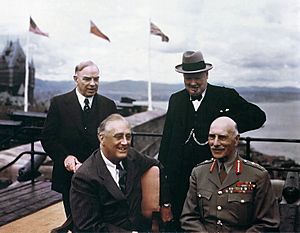
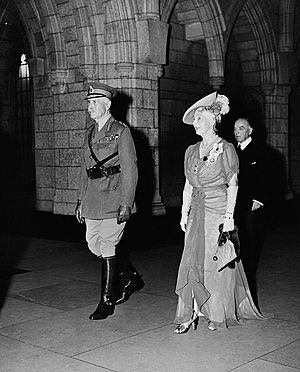
In Canada in the late 1930s, some people wanted a Canadian-born person to be governor general. However, the current governor general, Lord Tweedsmuir, died suddenly in 1940. Canada was also fighting in the Second World War. So, Canadian prime minister William Lyon Mackenzie King advised King George VI that it was not the right time for such a change.
Instead, Mackenzie King suggested the King's uncle, the Earl of Athlone. The Earl accepted. Athlone, his wife, and his aide-de-camp traveled to Canada. Their ship used a special zig-zag path to avoid submarines in the Atlantic Ocean. They arrived in Halifax, Nova Scotia. Then they took a train to Ottawa. Athlone was sworn in during a ceremony on 21 June 1940. The Athlones' three grandchildren lived with them in Canada during the war.
Athlone immediately supported the war effort. He traveled across Canada. He spent a lot of time with the troops. He visited soldiers training and those who were injured in hospitals. Athlone saw his role as a link between Canadians and their King. He told people in his speeches that the King was with them in their fight against Adolf Hitler and the Nazi regime.
The war also affected the Athlones directly. Many European royal families who had lost their homes found safety in Canada. They stayed at or near Rideau Hall, the governor general's residence. These guests included Crown Prince Olav and Crown Princess Märtha of Norway. Also, Grand Duchess Charlotte of Luxembourg, King Peter of Yugoslavia, King George of Greece, and Queen Wilhelmina of the Netherlands stayed there. In December 1941, British prime minister Winston Churchill also visited. He even held British Cabinet meetings from his bed at Rideau Hall.
Athlone also hosted important meetings in Quebec City. His prime minister, Mackenzie King, met with Churchill and United States president Franklin D. Roosevelt. These meetings were called the Quebec Conferences. The first was from 17 to 24 August 1943 at La Citadelle. The second was from 12 to 16 September 1944 at the Château Frontenac. At these meetings, the leaders planned how to win against Nazi Germany and Japan. When Germany fell on 8 May 1945 and Japan on 15 August, Athlone led the national celebrations. He spoke about Canada's future. He said it would be a time of rebuilding and peace.
During his time as Canada's viceroy, Athlone also helped with charities. He organized fun activities at Rideau Hall. These included tobogganing parties and skating lessons. He also enjoyed skiing in Gatineau Park. When he left Canada, he left a lasting gift. This was the Athlone Fellowship, a scholarship for engineering students.
Later Life
After his time as governor general ended in March 1946, Lord Athlone returned to the United Kingdom. He lived again at Kensington Palace. He retired from his military role as colonel of the 7th Queen's Own Hussars in September 1946. However, he still stayed involved in public life. He was part of the committee that organized the coronation of his great-niece, Queen Elizabeth II, in 1953. He also continued to be Chancellor of the University of London until 1955.
The Earl of Athlone passed away at Kensington on 16 January 1957. He was 82 years old. He was first buried at St George's Chapel, Windsor Castle. Later, on 15 May 1957, he was moved to the Royal Burial Ground at Frogmore. He was the last living great-grandchild of George III.
Honours
- Knight of the Order of the Garter (KG)
- Knight Grand Cross of the Most Honourable Order of the Bath (GCB)
- Knight Grand Cross of the Most Distinguished Order of St Michael and St George (GCMG)
- Knight Grand Cross of the Royal Victorian Order (GCVO)
- Companion of the Distinguished Service Order (DSO)
- Knight of Justice of the Venerable Order of St John (KStJ)
- Privy Counsellor (PC)
- Fellow of the Royal Society (FRS)
- Personal Aide-de-Camp to the King (ADC)
Honorific Eponyms
Many places and buildings are named after the Earl of Athlone:
- Athlone, a neighborhood in Edmonton, Alberta, Canada.
- Athlone, a community in Newfoundland and Labrador, Canada.
- Athlone, a suburb in Cape Town, South Africa.
- Athlone Power Station, a power plant in Cape Town, South Africa.
- Athlone Stadium, a sports stadium in Cape Town, South Africa.
- Athlone Elementary School, a school in Edmonton, Alberta.
- Athlone School, a school in Winnipeg, Manitoba.
- Athlone Boys High School, a school in Johannesburg, South Africa.
Arms
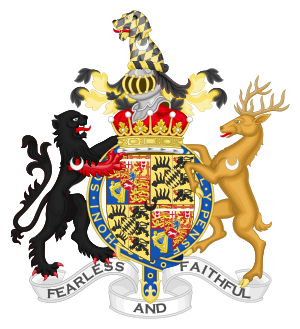 |
|
See also
- Rupert Cambridge, Viscount Trematon


